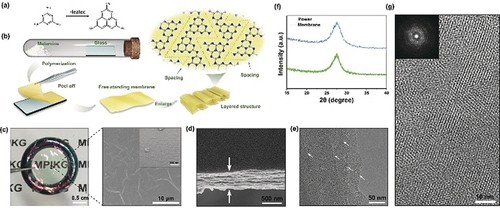Porous Membranes with pore size comparable to the Debye length could be adopted to convert energy. However, most 2D/3D porous membranes are fragile, thermolabile, and/or difficult to scale up, restricting their practical applications.
Prof. Lei Jiang’s group and Prof. Liping Wen’s group at Technical Institute of Physics and Chemistry of the Chinese Academy of Sciences and Prof. Markus Antonietti at Max Planck Institute of Colloids and Interfaces have developed the ultrathin free-standing carbon nitride (C3N4) membrane by CVD polymerization technique. The pore size equivalent to the Debye Length and charged surface endows the membrane unique property of selectively permeate the target ions. So that the robust membrane could realize the large-scale harvesting of salinity gradient energy. Furthermore, the 2D carbon nitride membrane is low-costing, easy preparation and ease of scale-up. It is ideal candidate for engineered new devices.
The thickness of the membrane range from 140 nm to 1 μm, which can be controlled by deposition conditions. The pH and concentration experiments confirm the beneficial effects of confinement and surface charge on the membrane’s conductivity. The ion selectivity is also crucial for the electric energy generation from salinity gradients, because it has been proven that the potential and current stem only from the charge separation.

Figure. a) The synthetic route of UFSCNM. b) Illustration of the vapor-deposition polymerization fabrication process and the molecular structure of UFSCNM. c) Optical and the enlarged SEM images of a UFSCNM peeled off a glass substrate after CVD. d) The cross-section of the multi-layered-UFSCNM. e) TEM image of layered structure; white arrows: layered edge. f) XRD of carbon nitride power and UFSCNM. g) High-resolution TEM and electron diffraction indicating that the UFSCNM is crystalline. (Image by Kai Xiao)
The study entitled “Nanofluidic Ion Transport and Energy Conversion through Ultrathin Free-Standing Polymeric Carbon Nitride Membranes” has been published in Angewandte Chemie International Edition.
Links: https://doi.org/10.1002/anie.201804299
E-mail: xiaokai@iccas.ac.cn

